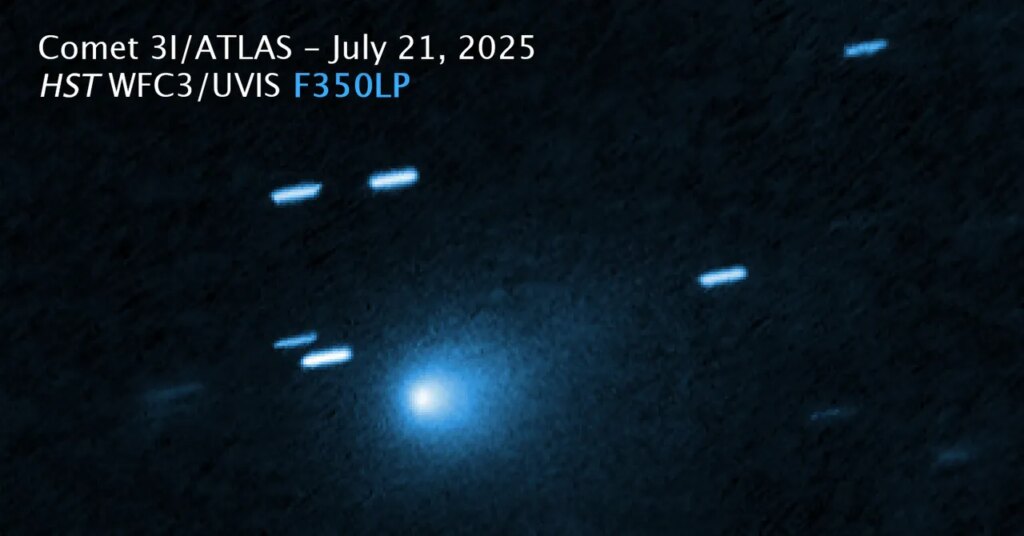Extra proof has emerged to assist the pure origin of comet 3I/Atlas. After a number of weeks of conspiracy theories, social media debates, and hypothesis on common podcasts reminiscent of Joe Rogan’s, this interstellar object continues to be a comet. The latest affirmation got here from an observatory in South Africa that detected the primary radio sign from 3I/Atlas.
However how? A radio sign? That must verify the article is technlogical in nature, would not it? The factor is, this is not a radio sign like a transmission emitted by a spacecraft. It is as a substitute a radio frequency sample detected by MeerKAT, a radio telescope composed of 64 antennas—every with a diameter of 13.5 meters—operated by the South African Radio Astronomy Observatory. And what did it detect? “OH absorption was detected on the 1665 MHz and 1667 MHz traces,” in response to the researchers.
What MeerKAT particularly detected had been traces of radio absorption by hydroxyl radicals, that’s, OH molecules, a sample that may be in keeping with typical comet exercise. The traces seem as absorption as a result of 3I/Atlas was very near the solar and the observing geometry favors absorption over emission. That is the phenomenon defined in WIRED a couple of days in the past when the controversy about non-gravitational acceleration arose: When comets attain their closest level to the solar, they sublimate ice into area and obtain a higher quantity of radiation. This additionally causes them to change their trajectory.
The hydroxyl radical (OH) can take up or emit radiation at particular frequencies (such because the 1665 and 1667 MHz traces) because of transitions in its vitality ranges. These OH spectral traces have been detected in nebulae, comets, and star-forming areas. OH helps astronomers map the star- and water-born areas of the universe as a result of it could actually “glow” brightly at radio frequencies underneath sure circumstances.
Is There Nonetheless Hope That It is Extra Than a Comet?
The detection was attainable on October 24, 5 days earlier than 3I/Atlas reached its closest level to the solar. MeerKAT tried to detect radio alerts earlier, on September 20 and 28, though it was unsuccessful. “5 weeks in the past, I inspired radio observatories like MeerKAT to seek for radio emission from 3I/ATLAS provided that the arrival path of 3I/ATLAS coincided to inside 9 levels with the arrival path of the Wow! Sign detected in 1977 at a frequency of 1.4204556 gigahertz,” astrophysicist Avi Loeb wrote in a Medium put up. “In response, I used to be assured that 3I/ATLAS will probably be monitored by radio observatories like MeerKAT.”
Loeb acknowledged that “no radio detection of 3I/ATLAS has been reported to date, apart from the OH absorption sign.” In fact, continued monitoring of the article would should be performed to find out whether or not the OH manufacturing is fixed or intermittent, together with components such because the extent and construction of the tail, to achieve extra stable conclusions about its nature.
Loeb has been has been among the many most vocal advocates of the speculation that 3I/Atlas has a technological origin. (And he has already invited Kim Kardashian to hitch his analysis crew.) The MeerKAT findings haven’t dampened his drive to probe the comet’s nature. “On March 16, 2026, 3I/ATLAS is predicted to move inside 53 million kilometers from Jupiter. At the moment, the Juno spacecraft will use its dipole antenna to seek for a radio sign from 3I/ATLAS at low frequencies starting from 50 hertz to 40 megahertz,” he wrote.
Will the MeerKAT detection be sufficient to place an finish to conspiracy theories about 3I/Atlas? Doubtless not, and no less than the debates have heightened most of the people’s consciousness of and curiosity in astrophysics. Within the meantime, you may view the trajectory of comet 3I/Atlas right here. And remember to mark December 19 on the calendar—that is when the interstellar visitor will attain its closest level to Earth.
This story first appeared on WIRED en Español and has been translated from Spanish.
{content material}
Supply: {feed_title}

